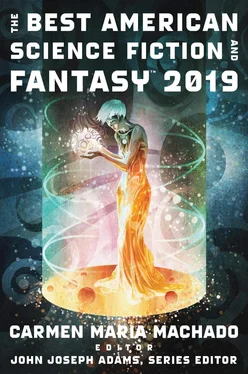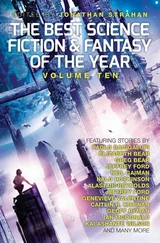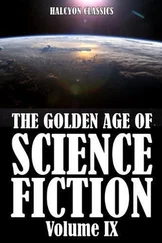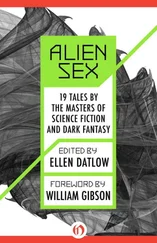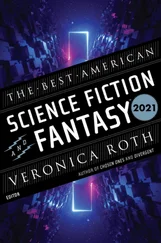I read for this edition of The Best American Science Fiction and Fantasy with no particular agenda other than my personal pleasure. These stories—as well as those listed as honorable mentions—come from literary magazines and publishers and genre magazines and publishers, from authors who have been recognized by genre and literary awards, by graduates of the Clarion and MFA programs, and by folks who haven’t done either. All of these details about the authors and the magazines that published their work are incidental. Here you will find an undeniable bias toward the use of formal constraints, [6] Sarah Gailey’s “STET,” Daryl Gregory’s “Nine Last Days on Planet Earth,” Ada Hoffmann’s “Variations on a Theme from Turandot ,” Theodore McCombs’s “Six Hangings in the Land of Unkillable Women,” P. Djèlí Clark’s “The Secret Lives of the Nine Negro Teeth of George Washington,” Nino Cipri’s “Dead Air,” and Silvia Park’s “Poor Unfortunate Fools.”
vibrant and muscular prose, [7] Particularly Usman Malik’s “Dead Lovers on Each Blade, Hung.”
ambitious weirdness. [8] Like LaShawn M. Wanak’s “Sister Rosetta Tharpe and Memphis Minnie Sing the Stumps Down Good,” Nana Kwame Adjei-Brenyah’s “Through the Flash.”
Many of these stories unnerved [9] Adam-Troy Castro’s “Pitcher Plant,” N. K. Jemisin’s “The Storyteller’s Replacement.”
me, and others impressed me with their scope [10] Brenda Peynado’s “The Kite Maker.”
and their intimacy. [11] Lesley Nneka Arimah’s “Skinned,” Kelly Robson’s “What Gentle Women Dare.”
There are several stories that reveal my weakness for compelling, complex, tender narratives about animals and animal-like creatures. [12] Seanan McGuire’s “What Everyone Knows,” Annalee Newitz’s “When Robot and Crow Saved East St. Louis.”
There is one story that made me salivate, [13] Martin Cahill’s “Godmeat.”
one that made me stand up out of my chair, [14] Sofia Samatar’s “Hard Mary.”
one that made me cry. [15] Adam R. Shannon’s “On the Day You Spend Forever with Your Dog.”
All of them made me happy to be a reader and writer in 2019.
And that’s all that matters, really. Why waste time drawing boundaries and performing ancient arguments and erecting dead horses and beating straw men and enacting coldness and smugness when you could be reading and salivating and standing and yelling and crying and learning and experiencing narrative pleasure and wonder and joy? Why, when you can do those things, would you do anything else?
—Carmen Maria Machado
Adam-Troy Castro
PITCHER PLANT
from Nightmare Magazine
The mansion is a study in architecture at war with itself. It’s not just the windows that don’t match and the turrets that don’t overlook anything and the roof that sits flat here while looming at impossible angles there. Nor is it just the exterior walls that seen from one angle seem rotted and decrepit and about to collapse, and seen from another gleam like jewels. Nor is it the gnarled skin of the columns that support the overhang at the front entrance, nor the glistening scarlet door that seems poised to open until you see that it’s not a real door at all but just a reasonable facsimile, carved with great love into what would otherwise be just a featureless brick wall.
It’s the way that none of this stays the same for more than a second or two; the way you can focus on one bay window or one turret or one balcony only to see it shift, retract, and sink beneath the house’s surface like something swallowed by an amoeba, only to emerge, seconds or minutes later, wearing a different shape, a different character, a different purpose in the overall design. It is impossible to face the mansion without knowing that it has always been changing, plank by plank, brick by brick, for as long as it has stood in this damned and isolated place beneath scarlet skies, in a blackened country, far from any roads.
You are impressed. Most normal houses provide no challenge to you. You’re not just an excellent thief; you’re the first thief. You find most locks nothing more than interesting trinkets, most fortresses nothing more than delusions built of mortar and stone. Some have required planning, some have been challenging, but few have stymied you for more than a few minutes. For you, the greatest difficulties involved in conquering any house have been first finding out that the house was there, then determining who and what were inside, and finally making the decision that the time had come to pass through the threshold, to claim those inside. But this house, by its very nature, has no threshold; it has no vestibule; it has no foyer. It has only a spastic geography that alters in hiccups. You are particularly fascinated by the moat: a gaping, watery trench that orbits the house like the blip on a radar screen, constantly excavating itself on one end while filling itself in on the other. The alligators that bob to the surface of that water, hissing and snapping, threatening bloody dismemberment to any wanderer unlucky enough to be standing on the grass when the earth beneath him becomes moat again, are no less threatening for being temporary. It’s a nice effect, determined to unnerve any potential intruders. You can only admire the tenants for their cleverness in managing such a thing, as you wait for the moat to fill in before you, enabling you to approach the house without wetting your feet.
The outer wall is warm. Of course, most inhabited buildings are warm, in a way that has little to do with surface temperature. They glow, in their own special way, with the warmth of the lives within. All houses bear the mark of the births and deaths, the lovemaking and the hate, the complacency and the fear, of those within. It may not be possible to track the entire course of their lives with a touch, but it’s hard not to know that inhabitants exist. But this house is warm in a different way. It feels like it’s boiling. It feels like a sack full of cats, scratching and clawing and tearing pieces from each other in their desperation to be free. You pull your hand away as if burned. You touch the wall again. And this time you endure the heat, lingering on it, giving yourself time to feel the sheer weight of all the pain imprisoned within. There’s unhappiness here: desperate unhappiness. And hopelessness too. There’s so much that breaking in is going to mean taking a deliberate step into somebody’s personal hell. This won’t deter you, of course. You’ve seen suffering before. But it’s good to know such things before getting down to work. You nod, and take a step back, and watch the shifting textures of the wall before you as they shift from brick to stucco to stone to unfinished wood. You wait until a single open window, flapping a flyspecked pull-down shade, comes around the corner and moves across the building face before you. The view through that window shows no details but shifts color and brightness as quickly as a strobe light. It looks like an opening into a blast furnace. It would take insanity or unlimited self-confidence or unconditional devotion to duty to willingly enter such a place. You don’t hesitate. You grab the window as it moves by, hop up onto the sill, and slide into the mansion with an ease that makes you wonder why you ever thought this was going to be difficult.
Your first glimpse of the mansion’s interior turns out to be a parlor. Its own geography doesn’t shift, which you find a relief after the crazy-quilt schizophrenia of the architecture outside. It’s still a nasty place, choked with dust, unlit except for a single shaft of sunlight entering through the same window that just admitted you. The sunlight doesn’t change angle or orientation, despite the window’s ever-changing attitude toward the sun; that by itself is enough to make you look back out that window so you can spot the motionless clouds and gnarled trees and the frozen position of a bird caught in midflight and from them make the determination that time inside the mansion has been compressed to fit inside a single captured moment. It’s an impressive trick, which bodes poorly for the number of even more impressive tricks that the tenants might still have waiting for you as you penetrate deeper and deeper into the house. You take it as a welcome indication that you’re now free to take as much time as you require.
Читать дальше
